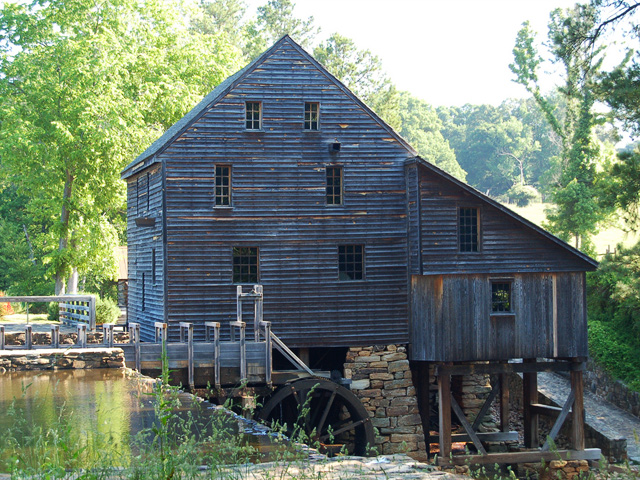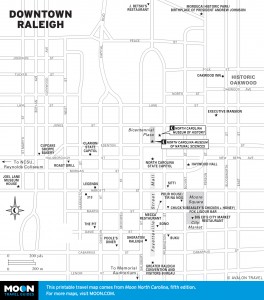
The mill that presides over the millrace at Historic Yates Mill County Park is nearly 200 years old. Photo © Suzie Tremmel, licensed Creative Commons Attribution.

Downtown Raleigh
The first time I heard of Raleigh was on The Andy Griffith Show. Any time trouble found Mayberry, it either came from “up North” or from Raleigh. Even though many of Andy’s observations of life in North Carolina are accurate, his assertion that Raleigh is a hive of citified depravity is just wrong. It is a great city, home to a number of universities and the state government (granted, many would agree that involves its own kind of depravity). Raleigh is one of the sparks that helps power the cultural engine of North Carolina.North Carolina State University is here, along with two historically African American universities, Shaw and Saint Augustine’s, and two small but well-known women’s colleges, Peace and Meredith. The North Carolina Museum of History is excellent, as are the Natural Sciences Museum and the North Carolina Museum of Art. There are a number of music and art festivals as well as the must-see event of the year, the State Fair.
The North Carolina Museum of Natural Sciences (Bicentennial Plaza, 11 W. Jones St., 919/707-9800, 9am-5pm Mon.-Wed. and Fri.-Sat., noon- 5pm Sun., 9am-9pm Thurs. and the 1st Fri. of the month, free) hosts national traveling exhibitions and is home to excellent permanent exhibits. “Mountains to the Sea” is a re-creation of the regional environments of the state, populated with live and mounted animals and plants. Stars of “Prehistoric North Carolina” include the world’s only publicly displayed skeleton of an Acrocanthosaurus, a 38-foot, 4.5-ton predatory dinosaur, and the remains of “Willo,” a 66-million-year-old small vegetarian dinosaur whose fossilized heart is a rare boon to paleontology. The whales whose skeletons hang in the Coastal Carolina exhibit are celebrities, each with its own interesting story, including “Trouble,” a sperm whale who washed up at Wrightsville Beach in 1928, and “Mayflower,” a right whale killed in a legendary 1874 struggle with Carolina whalers off Shackleford Banks.
In 2012 an 80,000-square-foot expansion called the Nature Research Center opened. Here visitors can watch scientists conduct research and experiments in the “Window on Research” areas. A three-story multimedia space provides plenty of room to show films, clips, and presentations. Other exhibits in this wing include displays on aquatics, astronomy, microbiology, and genetics.
Also on Bicentennial Plaza is the North Carolina Museum of History (5 E. Edenton St., 919/807-7900, 9am-5pm Mon.-Sat., noon-5pm Sun., free), where visitors learn about the history of the state’s contributions to the military, from the Revolutionary War to the Iraq War; about the musicians and genres that make this state one of the wellsprings of American music; about the handicrafts, including pottery, textiles, and furniture, created by centuries of renowned artisans; and about medicine in North Carolina, from traditional African American root medicine and Native American herbal treatments to the pharmaceutical and medical technology businesses that draw patients and researchers from around the world. You can also see a uniform worn by Harlem Globetrotter and Wilmington native Meadowlark Lemon and a stock car driven by Carolina legend Richard Petty. The Museum of History hosts concerts and many educational events throughout the year.
The North Carolina Museum of Art (2110 Blue Ridge Rd., 919/839-6262, 10am-5pm Tues.-Thurs. and Sat.-Sun., 10am-9pm Fri., free) is just outside the Beltline. Its collections include masterpieces from many eras and regions of the world, including ancient Egyptian, Greek, Roman, and pre-Columbian American art and the work of Botticelli, Giotto, Raphael, Monet, Georgia O’Keeffe, Thomas Hart Benton, and many more. The gallery is also home to one of the nation’s two Jewish ceremonial art collections and to collections of 19th- and 20th-century African art. Perhaps most impressive is the collection of sculptures by the French master Auguste Rodin.
A 160-acre outdoor gallery has miles of trails looping through it from one enormous outdoor art installation to the next. These include a metal tree that’s so organic that many visitors ask if the artist painted a real tree or wrapped one in foil. Throughout the park are opportunities to interact with the art pieces and the environment. A couple of the trails lead to the large outdoor amphitheater, which hosts concerts and film screenings during summer and fall.
The 1770s Joel Lane Museum House (St. Mary’s St. and W. Hargett St., 919/833-3431, 10am-2pm Wed.-Fri., 1pm- 4pm Sat. Mar.-mid-Dec., $5 adults, $4 seniors, $3 students) is Wake County’s oldest extant home. Costumed docents lead tours of the house and period gardens. The 1799 Haywood Hall (211 New Bern Place, 919/832-8357, call for hours, free) is another of Raleigh’s oldest buildings. Built for the state’s first elected treasurer and his family, it features a historic doll collection. A fee is charged for tours of the house and gardens.
Mordecai Historic Park (Mimosa St. and Wake Forest Rd., 919/857-4364, grounds dawn-dusk daily, hourly house tours 9am-4pm Tues.-Sat., 1pm-4pm Sun., 1-hour tours $5 adults, $3 seniors and ages 7-17, 30-minute tours $3 adults, $2 seniors and ages 7-17) includes a plantation house dating from the late-18th and early-19th centuries. It has restored dependencies and other buildings, including the birthplace of President Andrew Johnson.
More historic homes can be seen in Raleigh’s historic Oakwood Neighborhood, listed on the National Register of Historic Places. Structures mostly date from the late-19th century in this neighborhood, bounded by Franklin, Watauga, Linden, Jones, and Person Streets, and self-guided walking- and driving-tour brochures can be picked up at the Capital Area Visitor Information center inside the Museum of History on Bicentennial Plaza.
The North Carolina State Capitol (1 E. Edenton St., 919/733-4994, 9am-5pm Mon.-Sat., tours 11am and 2pm Sat., free), built in the 1830s, is a Greek Revival structure that has been restored to its antebellum appearance. Be alert when you visit the library; this is where the capitol’s many reported ghosts are allegedly most active. Guided tours last approximately 45 minutes.
The Executive Mansion (200 N. Blount St., 919/807-7950), built in the 1890s, is a lovely example of Victorian architecture, once described by President Franklin D. Roosevelt as possessing “the most beautiful governor’s residence interior in America.” Tours are available, but the hours vary according to state functions—it is still the home of the governor. It’s necessary to be with an official tour group; phone for more information.
The J. C. Raulston Arboretum (4415 Beryl Rd., across from Capitol City Lumber Company, 919/515-3132, 8am- 8pm daily Apr.-Oct., 8am-5pm daily Nov.- Mar., free) is a public garden focused on the development of ornamental plants suitable to the Southern climate. You can visit highly specialized areas devoted to white flowers, roses, and border plants; the 300- by 18-foot perennial border may cause some serious yard envy. The Raleigh Municipal Rose Garden (301 Pogue St., near North Carolina State University, 919/821-4579) is home to over 1,000 roses of 60 varieties. Carolina roses are blessed with an extra-long growing season, and the Municipal Rose Garden also features bulbs and other ornamental plants, so a visit to the garden is special any time of year. Another place for a scenic walk is Historic Yates Mill County Park (4620 Lake Wheeler Rd., 919/856-6675, 8am-sunset daily), a few miles south of downtown. The gristmill that presides over the millrace is nearly 200 years old. Hiking trails encircle the millpond.
A favorite place to visit in Raleigh is the State Farmers Market (1201 Agricultural St., 919/733-7417, 5am-6pm Mon.-Sat., 8am-6pm Sun., free), where you’ll find the best produce, finest meats, and all sorts of arts, crafts, candies, baked goods, bedding plants, garden plants, pots, and pretty things. A 30,000-square foot-pavilion where most of the farmers set up to sell their wares is the central focal point, but the Market Shoppes, at around half the size, are where you’ll find candy, baked goods, and other assorted North Carolina gifts, notions, soaps, and lotions.
Excerpted from the Fifth Edition of Moon North Carolina.